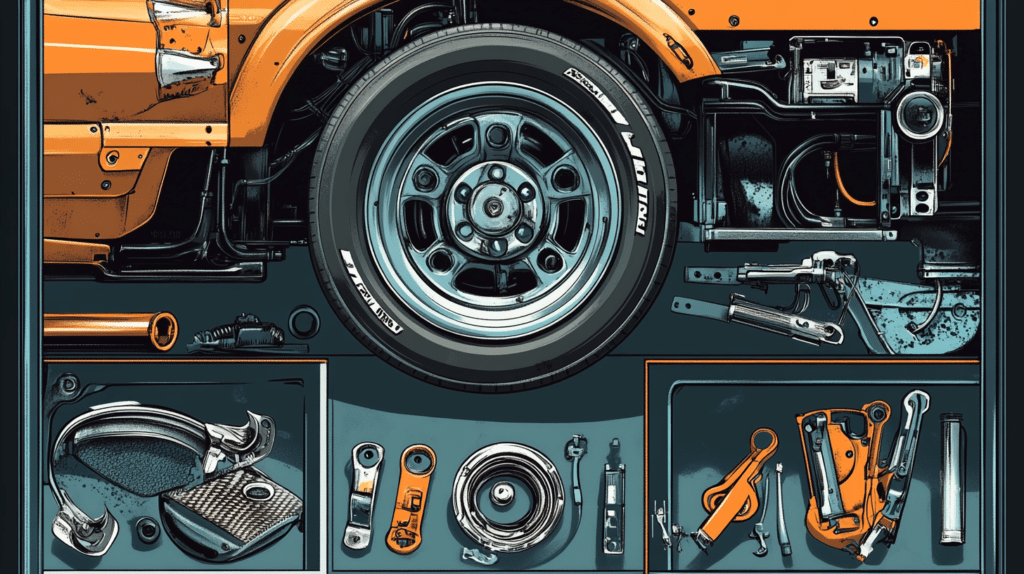Do your Honda Civic’s wheels need replacement? Most owners feel confused when selecting new wheels due to bolt pattern differences.
Not many people know that Honda has used different bolt patterns across Civic generations. This small detail can make a big difference in wheel fitment.
Understanding your Civic’s bolt pattern can save you time and money. The right knowledge helps you pick wheels that fit perfectly and keep your car safe on the road.
This guide will show you everything about Honda Civic bolt patterns. You’ll learn what patterns fit your model year and how to measure them correctly.
Let’s help you find the perfect wheels for your Civic.
Understanding Honda Bolt Patterns and Their Compatibility
What is the Bolt Pattern for a Honda?
Bolt patterns play a key role in your car’s safety. These patterns show how many bolts hold your wheel to the car and how far apart they sit. When the pattern matches perfectly, your wheels stay firmly in place while driving.
Honda uses two main bolt patterns across their car models. The 4x100mm pattern has four bolts in a circle with 100mm between opposite bolts. You’ll find this on older Civic models from 1973 to 2000.
The 5×114.3mm pattern uses five bolts placed 114.3mm apart. Most newer Honda models after 2000 use this pattern.
The bolt pattern affects how your wheels fit, what aftermarket wheels you can use, your car’s overall stability, and your driving safety.
Using wheels with the wrong bolt pattern can lead to poor wheel fit, shaking while driving, possible wheel separation, and a higher risk of accidents.
Getting the right bolt pattern ensures your wheels stay secure and your car runs smoothly. This small detail greatly affects how well your car performs on the road.
Bolt Patterns for Honda Vehicles
| Bolt Pattern | Years/Models | Purpose | Suitable Wheel Types |
|---|---|---|---|
| 4×100 | Civics (1973–2000) | Standard for older, smaller Honda cars | Smaller, lighter wheels |
| 5×114.3 | Most Honda models after 2000 | Provides better support for larger cars | Larger, heavier wheels |
| 4×114.3 | Rare Honda models | Limited use for specific Honda vehicles | Special or sports-oriented wheels |
Factors Affecting Compatibility with Aftermarket Wheels
When picking new wheels, the bolt pattern is just the start. The wheel offset shows how it sits on your car. A wrong offset can make wheels stick out too far or rub inside. The hub bore must match your car’s center hole size.
Too large or small won’t work right. Lug nuts need the right shape and size. Some wheels need special lug nuts to fit properly. Wheel width matters, too. Wider wheels might not fit under your car.
Tire size changes can affect how wheels work. These details ensure your new wheels work safely.
Why Compatibility Matters for Performance and Safety
The right bolt pattern keeps you safe on the road. Proper patterns help wheels stay balanced while driving. This reduces wear on your car’s parts. Good balance means better handling in turns. Your tires last longer with the right setup.
Braking works better when the wheels fit correctly. The car stays stable at high speeds. Your steering stays accurate and smooth. Wrong patterns can make wheels come loose. They can damage your car’s other parts, too.
Safety comes from using the right patterns. Your car runs better when everything fits right. This protects you and others on the road.
List of the Correct Bolt Patterns for Different Honda Models

Honda Civic Bolt Patterns by Generation
Different generations of the Honda Civic come with specific bolt patterns that have changed over time. Let’s look at how these patterns have evolved through the years.
Early Civic models, from 1973 to 2000, used a 4×100 bolt pattern. This means the wheels are attached with four lug nuts in a circle, spaced 100 millimeters apart.
The 4×100 pattern was standard on first through sixth-generation Civics. This setup worked well for that era’s smaller, lighter Civic models.
Starting with the seventh generation in 2000, Honda switched to a 5×114.3 bolt pattern for the Civic. This pattern uses five lug nuts spaced 114.3 millimeters apart. Honda made this change to support larger wheels and provide better stability.
The 5×114.3 pattern continues on current Civic models, offering improved strength and more wheel options.
This change in bolt patterns marks a clear line between older and newer Civic models, which matters when you pick replacement wheels.
Bolt Patterns for Accord, CR-V, and Odyssey
The Accord shows two main bolt patterns in its history. Models from 1976 to 1988 used 4x100mm, while all Accords since 1989 use 5×114.3mm.
The CR-V keeps things consistent. Since its 1997 launch, every CR-V has used the 5×114.3mm pattern. This fits the SUV’s size and purpose well.
Like the CR-V, the Odyssey minivan stays with one pattern. From its 1995 start, all Odyssey models use 5×114.3mm. This pattern supports family use and daily driving needs.
Each pattern matches the vehicle’s needs, ensuring safety and performance across Honda’s lineup.
Special Models: Type R and Ridgeline Bolt Patterns
Both the Civic Type R and Ridgeline use Honda’s standard 5×114.3mm bolt pattern. The Type R pairs this pattern with special performance wheels and wider tires. These parts help the car handle better at high speeds.
The Ridgeline truck uses the same pattern but with heavy-duty wheels. Its wheel setup focuses on carrying loads and lasting longer on rough roads.
Though these vehicles serve different purposes – racing versus hauling – they share the same bolt pattern. This makes wheel replacement simpler for owners while still meeting each vehicle’s specific needs.
Visual Guide: Bolt Pattern Tables
| Model | Years | Bolt Pattern |
|---|---|---|
| Civic (Early) | 1973 – 2000 | 4x100mm |
| Civic (Modern) | 2001 – Present | 5×114.3mm |
| Civic Type R | 2017 – Present | 5×114.3mm |
| Accord (Early) | Up to 1997 | 4×114.3mm |
| Accord (Modern) | 1998 – Present | 5×114.3mm |
| CR-V | 1997 – Present | 5×114.3mm |
| Odyssey | 1995 – Present | 5×114.3mm |
| Ridgeline | 2006 – Present | 5×114.3mm |
| Fit | 2001 – Present | 4x100mm |
| HR-V | 2016 – Present | 5×114.3mm |
How to Identify the Correct Bolt Pattern for a Specific Honda Model
Tools Required for Accurate Measurement
| Tool Name | Purpose | Level of Need |
|---|---|---|
| Measuring Tape | Measures distance between lug holes | Required |
| Steel Ruler | Makes straight-line measurements | Recommended |
| Bolt Pattern Gauge | Measures exact bolt circle size | Optional |
| Calipers | Provides precise hole-to-hole measurements | Optional |
| Wheel Template | Matches common bolt patterns quickly | Nice to have |
| Chalk or Marker | Marks measurement points on wheels | Recommended |
Steps to Measure Bolt Patterns at Home
You can check your Honda’s bolt pattern right in your driveway. First, make sure the wheel hub area is clean from dirt and rust. This helps you get the right measurements.
1. For four-lug patterns like older Civics, the process is simple. Take a ruler and measure from the middle of one lug hole straight across to the middle of the opposite hole. This gives you the pattern diameter.
2. Five-lug patterns, found on newer Hondas, need a different method. Start at the center of any lug hole. Then measure to the outer edge of the farthest lug hole across from it. This measurement helps you find the correct bolt circle diameter.
Write down your measurements in both inches and millimeters. Having both numbers helps when you look for new wheels. Double-check your numbers to make sure they’re right.
Identifying Even and Odd Lug Configurations
Understanding lug configurations helps you measure bolt patterns correctly. Even-numbered patterns, like 4-lug wheels, use a simple measuring method. Just measure straight across from one lug to another. The distance gives you the exact bolt circle number you need.
Five-lug patterns need a different approach. You can’t measure straight across because there’s no lug directly opposite another. Instead, measure from the center of one lug to the back of the lug that’s two positions over. This gives you the bolt circle measurement.
Honda mainly uses two patterns:
- 4-lug setup with 100mm spacing (found on older models)
- 5-lug setup with 114.3mm spacing (common on newer models)
For accurate results, use a proper measuring tool. A ruler or tape measure works for 4-lug patterns. For 5-lug wheels, special bolt pattern gauges give the most accurate readings.
Using Manuals and Professional Resources
Your Honda’s owner manual is the first place to check for correct bolt pattern details. The manual lists the exact measurements that Honda set for your car. Look in the “Wheels and Tires” section to find this information quickly.
If you can’t find your manual, Honda’s official website offers free digital copies. Just enter your car’s year and model number. You’ll get all the specs you need for your specific vehicle.
For a second opinion, talk to mechanics at certified Honda service centers. They work with these cars daily and know the right patterns for each model. Local tire shops can also measure your current bolt pattern to make sure you get the right fit.
These steps help you avoid costly mistakes when buying new wheels. Getting the right information means your wheels will fit properly the first time.
Comparisons Between Honda’s and Other Brands’ Bolt Patterns with Prices
Honda vs. Toyota Bolt Patterns
| Specification | Honda | Toyota |
|---|---|---|
| Older Models Pattern | 4x100mm | 4x100mm |
| Older Models Hub Bore | 64.1mm | 54.1mm |
| Current Models Pattern | 5×114.3mm | 5×114.3mm |
| Current Models Hub Bore | 64.1mm | 60.1mm |
| Car Lug Nut Thread | 12×1.5mm | 12×1.5mm |
| SUV/Truck Lug Nut Thread | 12×1.5mm | 14×1.5mm |
| Hub Adapter Needed? | Varies | Varies |
Comparison with Nissan and Other Japanese Brands
| Specification | Honda | Nissan | Mazda | Subaru |
|---|---|---|---|---|
| Modern Bolt Pattern | 5×114.3mm | 5×114.3mm | 5×114.3mm | 5×114.3mm |
| Center Bore Size | 64.1mm | 66.1mm | 67.1mm | 56.1mm |
| Early Model Pattern | 4x100mm | 4×114.3mm | 4x100mm | 4x100mm |
| Lug Nut Thread Size | 12×1.5mm | 12×1.25mm | 12×1.5mm | 12×1.25mm |
| Hub Adapter Required | No | Yes | Yes | Yes |
| Compatible With Honda Wheels | Yes | With Hub Rings | With Hub Rings | With Hub Rings |
Cost Breakdown of Wheels by Brand
Wheel Cost Comparison (Price per Wheel in USD)
|
Wheel Type |
Honda |
Toyota |
Nissan |
|
OEM Steel Wheels |
$120 |
$115 |
$125 |
|
OEM Alloy Wheels |
$250 |
$240 |
$260 |
|
Aftermarket Basic |
$100 |
$95 |
$105 |
|
Aftermarket Premium |
$300 |
$290 |
$310 |
How to Maintain Bolt Patterns on Your Honda

Why Maintenance Matters for Bolt Patterns
Regular checks of your wheel bolt patterns keep you safe on the road. When bolts get loose, your wheels might not sit properly on your car. This can cause your tires to wear unevenly and make your car pull to one side while driving.
Good maintenance includes checking the tightness of lug nuts monthly and after every wheel removal. You should also clean the mounting surface and threads to prevent rust build-up. Rust can make it hard to remove wheels when needed.
Proper care of your bolt patterns helps you spot problems early. Small issues like slightly loose bolts can turn into big problems if left unchecked. Taking care of these parts now costs less than fixing damage later.
Remember to use the right torque settings when tightening lug nuts. This keeps your wheels secure and helps them last longer.
Cleaning and Preventing Corrosion
Regular cleaning keeps your wheels safe and prevents damage. Start by removing loose dirt from your wheel hubs and lug nuts with water. Mix car soap with warm water for stuck-on brake dust and road dirt.
Use soft brushes or microfiber cloths to clean the parts gently. Hard brushes can scratch the metal surface. Pay extra attention to spaces between lug nuts where dirt often builds up.
After cleaning, dry all parts with a clean cloth. Apply protective spray or lubricant to the wheel hub and lug nut threads. These products form a barrier against moisture and salt, which cause rust.
For coastal areas or places that use road salt, clean wheels more often. Check lug nuts monthly for signs of rust. Quick action prevents small rust spots from becoming big problems.
Inspecting and Balancing Wheels Regularly
Regular wheel checks keep you safe on the road. Look at your wheels every month for signs of wear. Check lug nuts by trying to turn them with your fingers – if they move, they need tightening.
Keep an eye on the area around bolt holes. Small cracks or rust spots need quick attention from a mechanic. Odd noises or steering wheel shaking often mean your wheels need balancing.
Get your wheels checked by a professional yearly. You’ll also need a check after hitting big holes in the road. The mechanic will:
- Testing bolt hole roundness
- Checking lug nut torque
- Looking for metal stress signs
- Balancing all wheels
- Fixing alignment issues
These simple steps help your wheels last longer and keep you safer. They also save money by catching small problems before they grow bigger.
Proper Installation Tips for Long-Lasting Fit
Follow these simple steps for safe wheel installation on your Honda. Start by using the right lug nuts – they must match your car’s specifications. Each Honda model needs specific lug nuts and torque settings.
To install wheels correctly, follow the star or crisscross pattern when tightening. This method spreads the pressure evenly across the wheel. Begin with hand-tightening all lug nuts, then use a torque wrench to reach the proper settings.
For most Honda models, tighten lug nuts to 80-85 foot-pounds of torque. Take your car for a short drive after installation. Check the lug nuts again after 50 to 100 miles of driving – they might need slight adjustments as the wheels settle.
Remember: loose lug nuts can cause wheel wobble and potential safety issues. Regular checks help prevent these problems and keep your wheels secure.
Conclusion
Choosing the right wheels for your Honda matters more than many drivers think. Through this guide, we’ve seen how bolt patterns differ across Honda models and years.
Each setup serves a specific purpose, from the older 4×100 pattern to the current 5×114.3 standard.
We explored how these patterns compare with other Japanese car makers and what this means for wheel options. The right pattern ensures your wheels stay secure and your car runs safely.
The details about cost differences and performance levels help you make informed choices.
Remember that proper installation makes all the difference. When you follow the correct steps and torque settings, your wheels will serve you well for many miles ahead.


